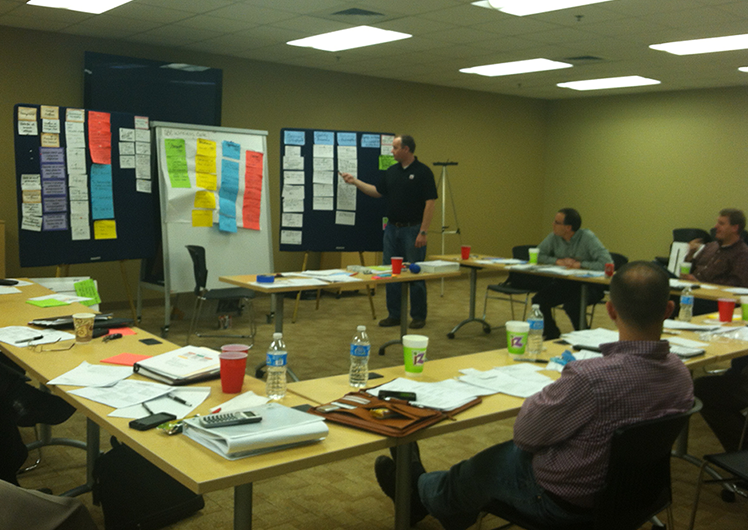Roll Up Your Sleeves – Living & Leading in a World of Constant Change, Part 3
Monday and Tuesday, we reviewed these two concepts:
1- One Unshakable Truth – Everyone has unseen battles they are fighting. Be kind.
2- Change is not the same as transition. Change is an event. Transition is the emotional stages people go through when change happens.
Today’s observation is – Role Clarity Counts. People are structure-seeking beings. When change hits, each person needs to talk about his or her role and how the change will affect them and the ones they love.
I’d like to share a couple of stories and a role clarity technique that I have found useful at certain times.
Promoted to a new role: Three years ago, I was coaching a young lady who was a competent and capable up-and-coming leader. She was just promoted from working in a department to leading the department. She was in her early 30s, and most of the people in the department were in their mid 40s and 50s. The promotion was well deserved, and most people knew that and were accepting – but not everyone. She was wondering how to make this transition work especially since most of the people in the department were a good deal older than she was. She wasn’t just going from Bud to Boss; the grapevine message was that she was going from Baby to Boss.
So, we talked about her concerns and then about how teams are built. We discussed the structure and steps to set up a team that works: 1st set shared goals > 2nd clarify roles> 3rd enhance relationships and 4th simplify procedures. Fortunately, the department had some goals already set and most procedures working okay, so roles and relationships became her focus. A few days later, she held a team alignment meeting. She began by reviewing the goals with the team to see if everyone understood and agreed these objectives were still worth working on. All agreed. Then they reviewed a few of their procedures and processes, and she asked them to make notes about ideas for improving those sometime in the future.
Then she stood, turned to a flipchart and wrote two questions: 1- What do you need from a manager? 2 – What do you not need from a manager? The team just sat there. No one said a thing. I think they were stunned at her approach. She did not come in promoting or advocating for her power position, as their last manager had. Rather than lay down the rules, she simply inquired how they could work together. Finally, one person spoke up and the 2 questions on the flipchart began to fill up. The team talked about the comments and made some agreements. Then one of the team members asked her, “What do you need from us? What do you not need from us?” The new leader had earned the right to make a request and she did. Her first few months on the road to building a team were not completely smooth but a lot of bumps were missed, and potholes were avoided because she began by making sure everyone understood where everyone stood and sat as they moved along to become a team.
Role tune-up exercise in good times: When things change because of positive business evolution or growth, roles can drift and need correction from time to time. This is difficult to do with job description updates. With the pace that things are changing these days, no work would get done, because of time spent rewriting job profiles. So, here is a simple team role clarity input/output method that I recommend teams to at least once a year. Instructions: Find a room with lots of wall space . Give each team member a Post-it note flip-chart size sheet. Get them to write their name and job title across the top. Then make 3 columns with the headings and questions, as illustrated here:

Next, everyone needs to stick their poster on the wall. Then each person is to complete the questions on every team member’s wall posters, but they cannot complete their own. Give people 5 minutes at each poster and then move to the next, round robin. End by having each person comment on what was written by others and add or delete. Finally, you lead the group to agree on any adjustments that need to be made on each role sheet going forward. Note: This could also be done virtually with screen sharing.
Role clarity when dramatic, unexpected change hits: Don’t use the exercise I just presented. Groupthink does not work now. When major economic or political shifts or a new corporate strategy forces an organization to make major structural changes like restructuring, downsizing or mass transfers across the organization, people are going through the ways of transition. (See observations 1 and 2.) At this time, humans need simple straightforward answers on next steps in their workplace role and personal careers so they can take care of their life. Until personal career issues are settled, employees will be too preoccupied to be productive. Get these questions answered in a hurry so people can get on with business. These questions include:
• Will I keep my job?
• Will my pay and benefits be affected?
• What about advancement opportunities?
• Will I have a new boss?
• What is expected of me now?
If you do not know these answers, tell people that you are unsure, promise to get some answers, and follow through with your promise. If you do not provide information, your employees will provide their own. Fill the grapevine with accurate information daily, because the company grapevine is always growing in one direction or another.
see additional resources below
Journal Entry: Which of the situations described here do you find yourself in these days? Is there something you have gleaned from this information that you can use in your Leadership and Life?
For more comprehensive approach to managing dramatic organizational change, read the article “Leading the people who are left” at my website.
Tomorrow I will discuss observation #4 Principles set the pace. Clarity of personal values and shared values guide effective behavior and help set a pace so people can move steadily forward and even grow through their wilderness experience.



